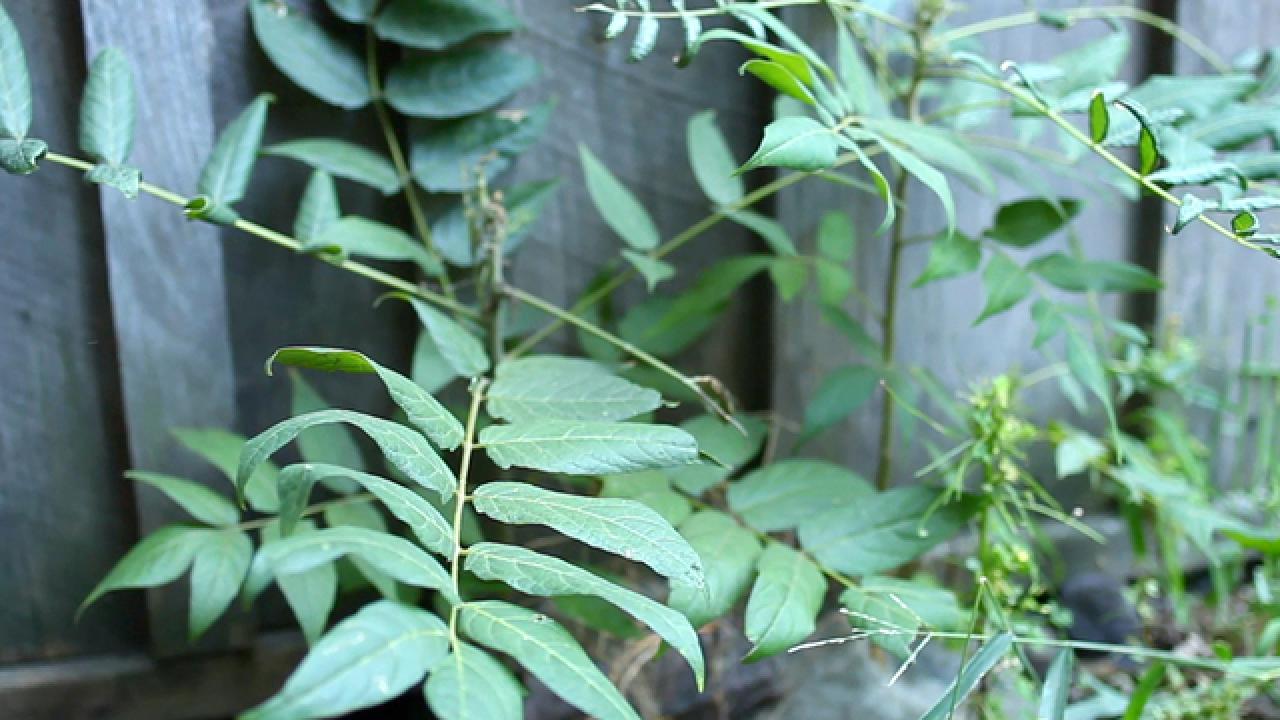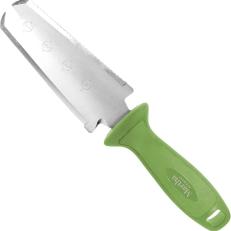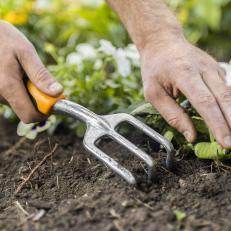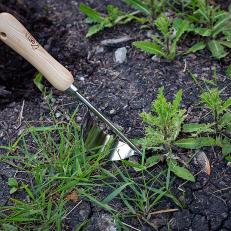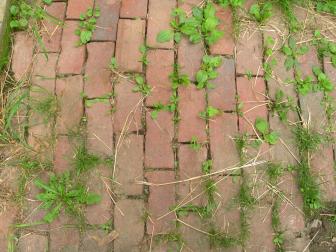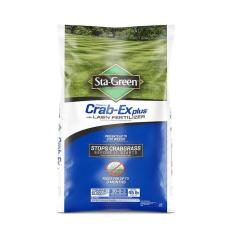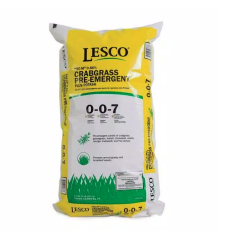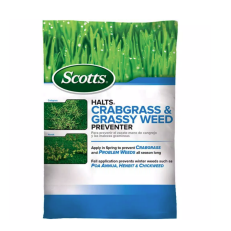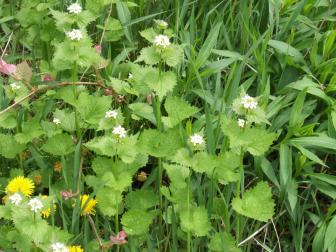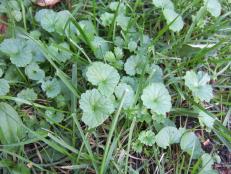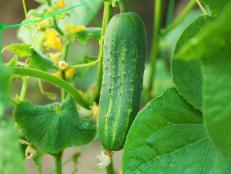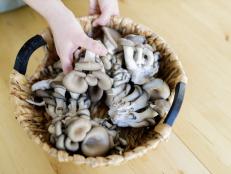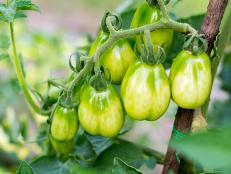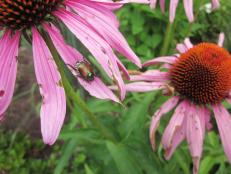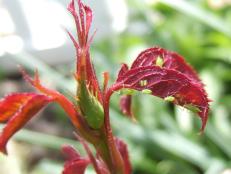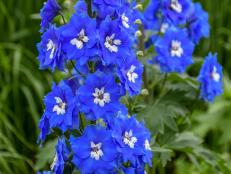How to Get Rid of Weeds
Make this garden chore fly by with these simple, fast and easy tips for getting rid of weeds. Plus, get advice for preventing weeds in the garden.
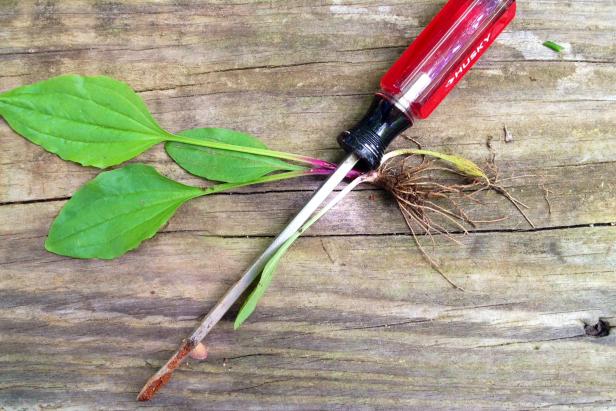
Photo by Lynn Coulter
Be sure you pull up weeds by their roots, and don't just yank out the leaves. They can re-grow if even small pieces of their roots remain. A weed puller tool can be helpful, but a screwdriver may also do the trick.

You’ve probably heard the saying that weeds are simply plants that grow where they’re not wanted. Maybe somebody — somewhere — tolerates weeds, but most of us want to rip them out of our lawns and gardens and toss them in the sun to die.
Maybe that sounds brutal. But most weeds are aggressive and invasive, and left unchecked, they’ll crowd out desirable plants. Even after you pull the weeds, you can’t toss them in a compost pile, because any seeds that have already formed can sprout. It’s not a good idea to leave them on top of the soil, either, thinking they’ll wither. An unexpected rain or some runoff from your hose can wash dirt over them, and they’ll stage a comeback.
Remember: Weeds are survivors by nature, so don’t be afraid to fight dirty. Try our tips to make the chore of weeding fly by.
25 Garden Tools and Essentials for Year-Round Care
When you're ready to grow, use our shopping list to find great garden tools, gear and more.
Top Tips for Getting Rid of Weeds
1. Don’t Leave the Roots Behind
This is the most important rule of weeding. If you yank only the leaves, weeds will grow back. Grab the weed close to the ground and pull straight up. Do it right the first time, you’re done. (Unless pieces of the root break off in the ground. It happens.)
You'll have less work to do in the future if you attack the weeds as soon as they're up. Young weeds have small roots, which makes them easier to pull and increases your chances of getting the entire plant.
2. Weed After a Rain
Weeds will come up more easily when the ground is moist. However, be careful about walking around in a wet garden; you don’t want to compact the soil. If you can’t reach in, put down some boards and walk on them to help distribute your weight.
3. Or, Water Your Garden First
If there’s no rain in sight, water your garden and start pulling. It’s easier to remove weeds while they’re small, so don’t wait for Mother Nature if you’re in a dry spell.
4. Keep a Garden Fork or Trowel in Your Pocket
Carry a garden fork or trowel with you when you’re outside so you can attack baby weeds the minute you spot them.
5. Use a Hoe When ...
If the soil is dry, or if your weeds are too small to pull by hand, use a hoe. Keep the blade sharp for a fast cleanup in large areas.
6. Use the Right Tool
Hoes with triangular blades are good for closely spaced rows and underneath plants. Scuffle or loop hoes are pushed and then pulled back over the soil, doing double-duty as they scrape. Slice the weed's roots just under the surface of the soil. Remember: When you loosen the soil, you're exposing any fallen seeds to the light, which can cause them to germinate, so try not to disturb the soil too much.
For weeds with longer roots, use a garden knife, dandelion digger or hand weeder — a long, slender tool that looks like a screwdriver with a forked tip.
Buy Weeding Tools
7. Don't Overlook the Handy Screwdriver
Got weeds shooting up between pavers or in the cracks of a driveway? Use an old screwdriver to pry them out.
8. Off With Their Heads
If you can’t get weeds up by their roots, chop their heads off every now and then. That will prevent them from setting seeds, and with any luck, they’ll eventually die.
9. Use Mulch With a Weed Preventer Mixed In
Some products keep weeds from germinating for up to six months. By then, you’ll probably need to add more mulch anyway.
10. Don’t Leave Bare Spots
Weeds love to move in, so space plants as recommended on their tags or labels, or even closer. Mulch unused beds, or sow a cover crop at the end of the season.
11. Know What You're Up Against
Before you resort to herbicides, know your enemy. Identify your weeds and pick the right product to eliminate it. Then hang a spray bottle filled with weed killer on your mower and pause to spritz as needed when you cut the grass.
12. Treat Weeds With Spot Killers
If you have a few weeds popping up through cracks in your patio or walkway, pour a little bleach on them and wait a couple of days to pull them up. A mixture of one cup of salt dissolved in 2 cups of hot water will also work. Some gardeners spray with full-strength apple cider or white vinegar, but rain dilutes the effectiveness of this solution. Be careful not to get any of these on your grass or the desirable plants in your borders and beds.
Make Your Own Natural Weed Killer
Tackle troublesome garden weeds the sustainable way with this easy-to-make homemade weed killer.
Weed killers can be tricky to use, because if you get them on your desirable plants, they'll kill them, too. This can happen, for example, if you're spraying weeds on a windy day and the spray drifts.
Herbicide glyphosates are effective and work by spreading from a plant's leaves to its roots. Available as liquids, solids or ready-to-use products, they eventually break down in the soil. However, glyphosates work only on growing weeds; they are not pre-emergents. And while they've been used in the U.S. for over 30 years, debate continues about whether they present health risks to humans. See the US. Environmental Protection Agency website for up-to-date news and additional information on using them.
How to Get Rid of Common Weeds
Dandelion
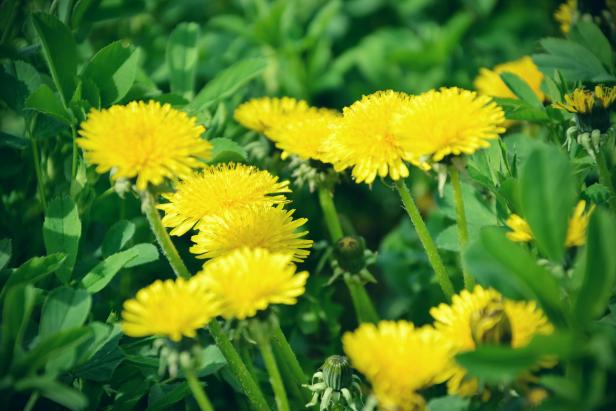
Shutterstock/Lukas Beno
Dandelions entrench themselves in your lawn or garden with deep taproots that can grow as long as 15 feet. The best way to keep them from spoiling your lawn is to grow thick turf. To get rid of dandelions, you can spray them or dig them out. If spraying, kick dandelions a bit first to scuff and wound the leaves — it helps the spray penetrate better. If digging, make sure you get at least 2 inches of taproot or they’ll return as two plants.
Wild Violets
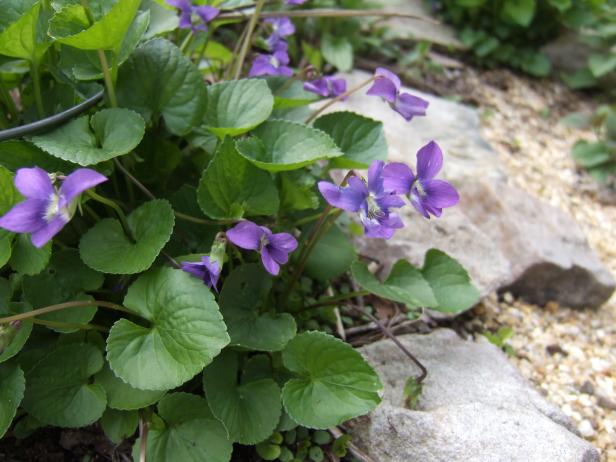
Julie Martens Forney
These common perennial weeds (though some consider them a wildflower) spread by underground sems and seeds and thrives in moist, shady sites. Vigilant hand weeding along with targeted herbicide use is required to eradicate these weeds, if you must.
Thistle
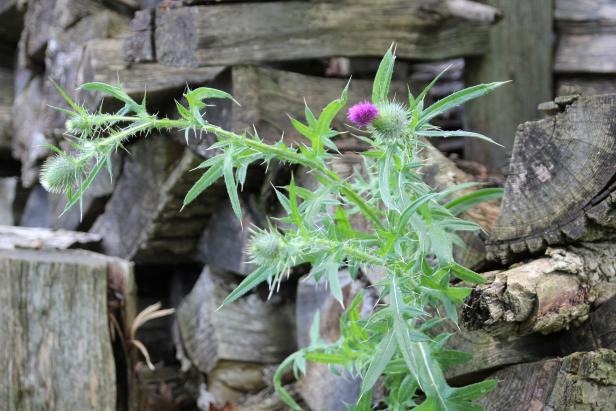
Image courtesy of Preen
Prickly thistle grows from seeds that blow into your yard or it can sprout from root pieces, which may sneak in with bulk topsoil or mulch loads. Mature plants can reach 5 to 8 feet tall. Control through weeding, but dig deeply to get the horizontal root. If you use an herbicide, the best time to spray is as soon as leaves break ground. Spray repeatedly through the growing season.
Bindweed
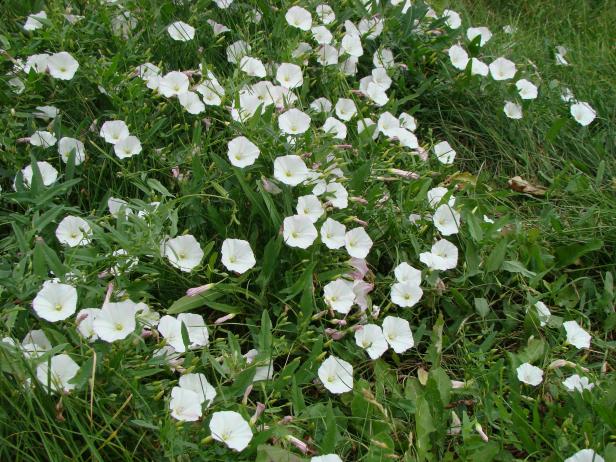
Tatiana Belkina / Shutterstock.com
This invasive perennial grows along the ground and will spread over anything in its path, wrapping its stems around any structure it comes across much like a pole bean. Hedge bindweed (Convolvulus sepium) spreads by seed and creeping underground stems; field bindweed (Convolvulus arvensis) spreads by weeds and roots, which grow up to 30 feet deep. This plant, also known as wild morning glory, opens flowers that look like morning glory and can persist for up to 20 years. Since these plants are tough to eradicate, it’s important not to let any get a foothold in your yard. Pull them as soon as you see them, and continue pulling each time they emerge.
Chickweed
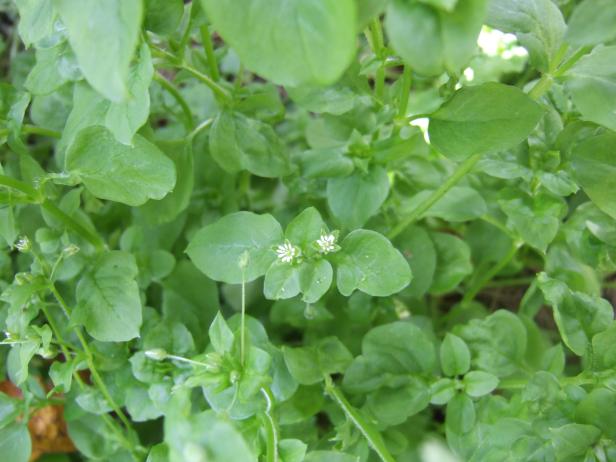
Julie Martens Forney
Chickweed forms a low-growing crown of stems that spread and sprawl up to 18 inches in a planting bed. Chickweed can infest lawns with thin grass and heavy, moist soil. Hand-pulling works fine to control small outbreaks. Get the plants before they seed. You can use herbicides effective against chickweed (check the label) for larger infestations.
Yellow Wood Sorrel
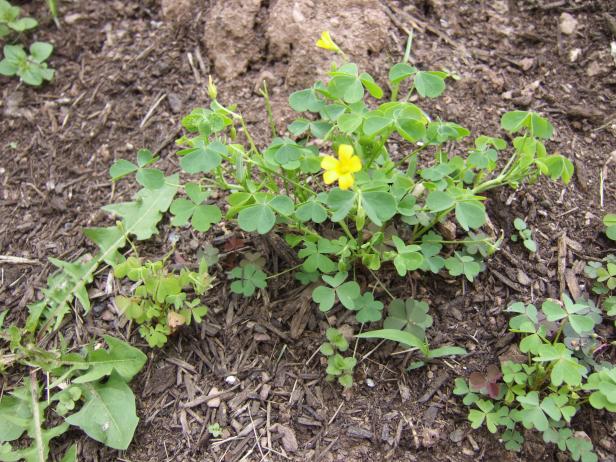
Julie Martens Forney
Also known as oxalis, this weed resembles clover with heart-shaped leaves and yellow flowers. Upgright seed pods form after the blooms fade then explode when ripe. Oxalis also roots from stem pieces and can find a home in a variety of places including lawns, planting beds, gravel drives or vegetable garden paths. Rid your lawn of oxalis by encouraging thick, healthy grass. In planting beds, carefully hand-pull or spray with herbicide.
Crabgrass
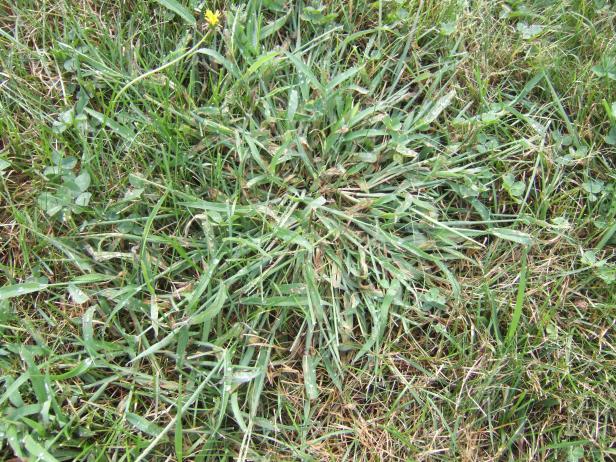
Julie Martens Forney
This summer annual grassy weed germates in the spring from seeds. Crabgrass is characterized by rough, pointy, light-green blades that grow in clumps that spread aggressively. The most popular and effective way to control crabgrass is to apply a pre-emergent herbicide. Pre-emergents prevent crabgrass seedlings from maturing, therefore solving a crabgrass problem before it begins. A thick, luxuriant bed of grass is the best crabgrass deterrent. Regular aeration and proper mowing go a long way to maintaining a healthy lawn. Crabgrass clumps can be pulled easily in spring when they have shallow roots.
Buy Crabgrass Pre-Emergent
Nutsedge
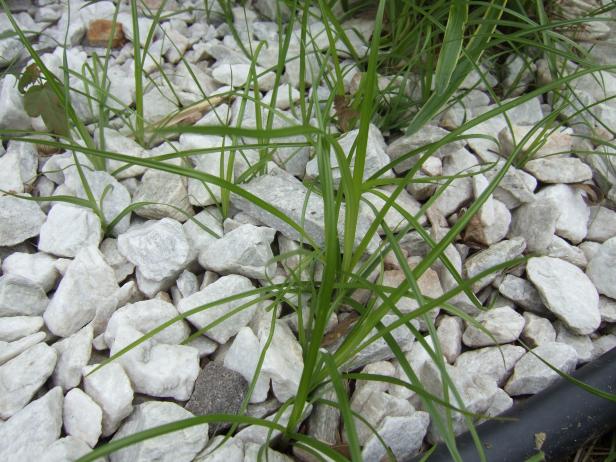
Julie Martens Forney
Nutsedge not only produces seed heads, but also forms small bulbs or nuts underground. You can pull a nutsedge plant and still leave a network of nuts in the soil, each one capable of generating a new plant. The best approach is to spray plants with an herbicide. For nutsedge that’s growing in lawn, be sure to choose a chemical that won’t kill grass.
12 Common Weeds 25 Photos
Got weeds? Learn how to identify common weeds, including tips on why they’re thriving and how to get them under control.
How to Prevent Weeds in Your Garden
Block With a Weed Barrier
Landscape fabric is great for blocking sunlight, so weeds can't grow. If you don't want to purchase a ready-made barrier, try using strips of black plastic or even old carpet (a solid piece of plastic or carpet would prevent water from soaking into the soil). Cover them with an attractive mulch, if you like.
Use Mulch
Once you’ve got the weeds out of your garden, keep them from coming back with a 3-inch layer of mulch. Straw will work, as long as it doesn’t contain weed seeds. Pine straw, wood chips, and bark chips also suppress weeds by blocking sunlight, and they'll break down slowly and amend your soil.
Pine straw tends to acidify the soil as it breaks down, so it's good to use around azaleas and other acid-loving plants. Straw and sawdust mulches use nitrogen as they decompose, so you may need to add some nitrogen fertilizer if you use them.
